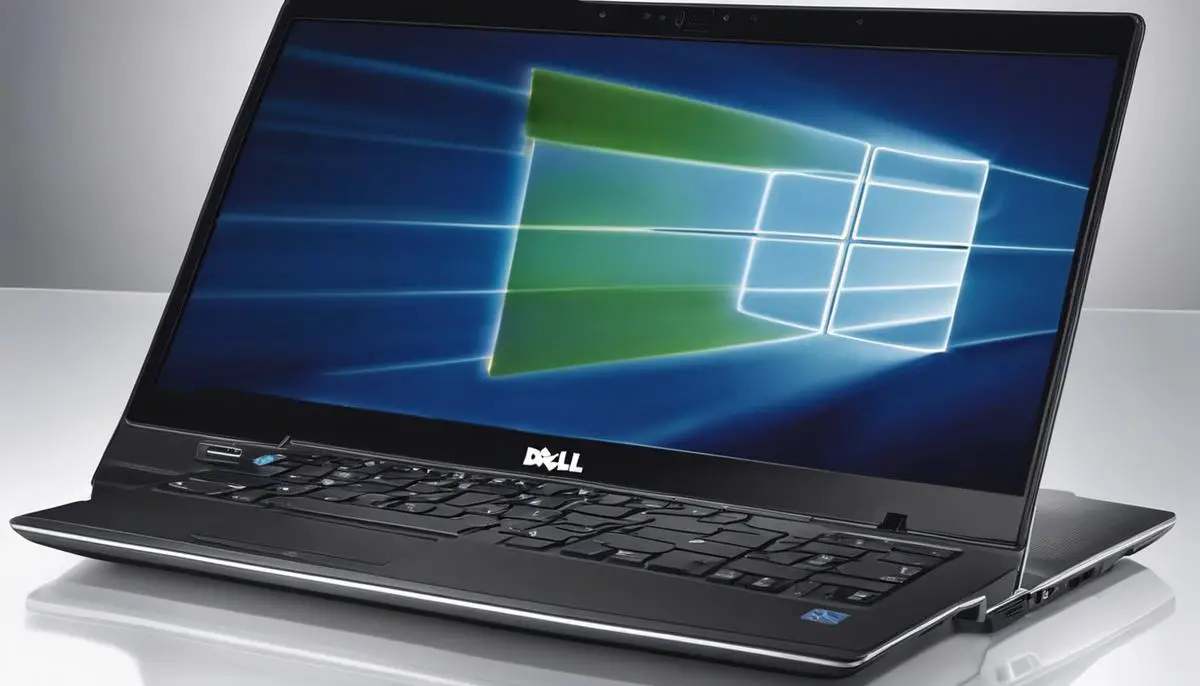We’ve all been there: you press the power button on your Dell laptop and wait with bated breath, only to be met with a stark, black screen. Before you consign your laptop to the electronic afterlife, it’s worth diving into some troubleshooting techniques that could breathe life back into your trusty device. A black screen can be symptomatic of a variety of issues—from simple glitches to more complex hardware malfunctions—but fear not, as we’ll guide you through a series of steps designed to illuminate the root cause and, hopefully, resolve the issue. From the straightforward hard reset procedure to the more nuanced nuances of BIOS/UEFI troubleshooting, we’ll arm you with the knowledge you need to diagnose and address that daunting black screen.
Hard Reset Procedure
Solving the Dreaded Black Screen: The Hard Reset Solution for Dell Laptops
Experiencing a black screen of death on your Dell laptop can feel akin to tech purgatory, yet it’s often no match for a hard reset. Known as a potent troubleshoot fix, performing a hard reset can miraculously resurrect your Dell laptop from the digital abyss. Let’s dissect why this simple maneuver is a go-to solution and how to execute it flawlessly.
Why Hard Reset Works: The Tech Rationale
First, understanding the ‘why’ behind a hard reset’s magic is critical. A black screen can be symptomatic of numerous issues: corrupt system files, driver conflicts, or even a drained battery. At its core, a hard reset clears the motherboard’s memory (RAM), shutting down any rogue processes and giving your laptop a clean state to restart from. It’s equivalent to a system detox, flushing out errors that software can’t latch onto and resolve.
The Step-by-Step Guide to a Hard Reset:
- Power Down Properly: Initiate a standard shutdown by holding the power button for around 10 seconds. This ensures all running processes are terminated.
- Unplug to Regroup: Disconnect the power adapter from the laptop to eliminate any source of external power. If your laptop runs on external peripherals, detach those as well.
- Battery Ejection Maneuver: If your Dell model permits, remove the battery. This is the equivalent of pulling the plug on lingering power reserves that could be sustaining the black screen condition.
- The Static Release: Press and hold the power button for 15-30 seconds. No, this isn’t an exercise in patience; it’s draining residual power and static electricity from the system.
- Resurrection Sequence: If you removed the battery, place it back into its snug harbor. Plug the laptop back into its power source but leave external devices disconnected for now.
- Ignition and Observation: Power on your laptop and observe. Ideally, the Dell logo graces your screen, signaling a successful hard reset.
- Peripheral Reconnaissance: Only reconnect external devices once the system has booted successfully. This incremental addition helps identify if a specific device is the root of the issue.
A hard reset isn’t a silver bullet for all system maladies, but it’s an uncomplicated first line of defense against the black screen conundrum on a Dell laptop. Its efficacy lies in its simplicity — a reset of the system’s electrical state can clear hitches that software can’t tackle. When your tech toolkit needs a reliable fix, remembering the hard reset trick could be a timesaver before diving into more intricate solutions. Remember: when in doubt, reboot it out — it’s not just an adage; it’s a practical first step in the modern tech troubleshooter’s handbook.

Checking Display Issues
Moving past the tried-and-true hard reset, it’s time to delve into the realm of display connection issues, which might very well cause your Dell laptop to sport a black curtain over your digital workspace. Tech enthusiasts understand that there are multiple layers to hardware problems, and when a basic reset doesn’t cut it, we don’t shrug — we dive deeper.
A Dell laptop black screen can often masquerade as a signal of despair, but beneath the surface, it’s a mystery awaiting to be solved. If a hard reset has left you in the dark, it’s possible the display connection is the real culprit. Here’s how to pinpoint and possibly fix a display connection fault.
Check the Display Brightness:
First, let’s start with the basics. Ensure your laptop’s brightness is not turned down. It may sound trivial, but even the most technologically savvy can overlook simple solutions. Use the function keys to adjust the brightness (typically Fn + Arrow Up/Arrow Down).
Examine the Display Assembly:
With that out of the way, it’s time to probe further. Begin by examining the laptop’s hinge area when opening and closing the lid. If there are loose or damaged components in the hinge, it can impact the display cable’s connection.
Inspect the Display Cable Connection:
Misalignment or looseness in the display cable can lead to a black screen. Power down your laptop and carefully remove the bezel or bottom cover if you’re comfortable with a DIY approach. Locate the display cable, which usually connects the motherboard to the display. Ensure it’s seated correctly and has no signs of damage. If unsure about tinkering with hardware, contact support or a professional.
Test With an External Monitor:
To determine whether the issue is with the screen or the laptop itself, connect an external monitor. If an external display works, the issue likely lies within the built-in display or its cables, ruling out GPU issues.
Update or Rollback Graphics Drivers:
Assuming you’ve got visual through an external monitor, it’s time to scrutinize the drivers. Device Manager is your starting point; locate Display Adapters and check for updates. Sometimes updates can cause issues, so consider rolling back to a previous driver version if problems began after an update.
BIOS/UEFI Check-Up:
Another potential remedy is checking for firmware updates. Access the BIOS/UEFI settings during boot-up and look for any available updates. These can enhance compatibility and fix a plethora of issues.
Finally, be strategic. If all DIY methods fail, warranty or professional service is your friend. A black screen on your Dell laptop can be an inconvenience, but with the right tools and a bit of tech savvy, it often becomes another problem solved, another day in the life of a tech enthusiast. Remember, the objective is casual troubleshooting with the resources at hand before considering hardware replacements or professional repairs.

BIOS/UEFI Troubleshooting
When the much-dreaded black screen still looms after a hard reset, it’s time to delve deeper into the systematic universe of your laptop’s BIOS/UEFI. This built-in firmware interface is the foundation for booting up your Dell system, and probing its settings might just illuminate the path to resolution.
Before proceeding, ensure the black screen isn’t a fluke. Perform a quick smokescreen by connecting to an external monitor. If the external display works, the main screen or graphics card could be the culprits, prompting a more hands-on hardware troubleshooting. Assuming the black screen persists, it’s time to intervene through the BIOS/UEFI.
First, power up and promptly tap the F2 key. This should summon the BIOS/UEFI. No display? Not to worry. The blind key strike method is next. Unplug all peripherals, power on, and blind-tap ‘F2’ or if ‘F2’ fails, reboot and try ‘F12’ for the boot menu, then ‘F2’. If still unlucky, proceed to draining residual power—unplug, remove the battery if possible, press and hold the power button for a minute, and then attempt entry into the BIOS/UEFI again.
Inside BIOS/UEFI, strip down to the essentials. Switch to built-in graphics if you’re riding with a discrete card – this eliminates potential conflicts. Next, execute the BIOS/UEFI’s built-in diagnostic tools. Run them. Delve into component tests, specifically targeting display issues. These tests are comprehensive and dismiss the need for third-party diagnostics. Find anything? Follow on-screen instructions to fix or to fetch more data about the problem.
Reset to defaults if needed. Navigate to ‘Restore Settings’ or ‘Load Default Options’ – often found in the ‘Exit’ menu. This is a clean slate tactic, eliminating any misconfiguration that could darken your screen.
Can’t access BIOS/UEFI or the screen remains an abyss? We look to flash or update the BIOS/UEFI. Access another device, visit Dell’s support page, enter your laptop’s service tag, and download the latest BIOS version. Utilize Dell’s instructions to create a BIOS recovery USB and harness its power to either reflash or update the BIOS/UEFI.
Lasthly, never ignore the elephant in the room – if the laptop is still within warranty bounds, or if each attempt signifies a battle lost, professional assistance is a wise, time-saving investment. Technical support teams are well-equipped to investigate further, potentially indicating a hardware issue not readily resolvable through firmware fiddling.
Persistence is key in BIOS/UEFI troubleshooting. Exhaust these avenues and you stand a high chance of reviving your Dell laptop from the black screen abyss, maintaining the productivity and enjoyment that technology offers to those who understand its nuanced language.

Tackling a black screen on your Dell laptop can feel like navigating a dark labyrinth, but with the right tools and knowledge, you can emerge into the light. We’ve traversed the complexities of hard resets, parsed through the particulars of display dilemmas, and delved into the depths of BIOS/UEFI. Armed with these insights, you’re now better prepared to face these challenges head-on and restore your Dell laptop to its full, luminous functionality. Remember, the darkness of a black screen is often just a temporary shadow, and with a methodical approach, you can dispel it and get back to your digital day-to-day.